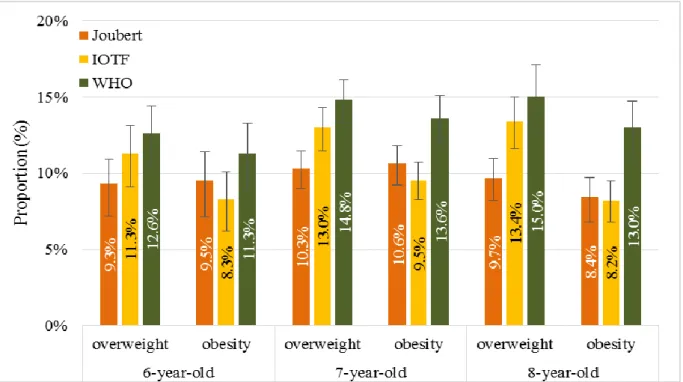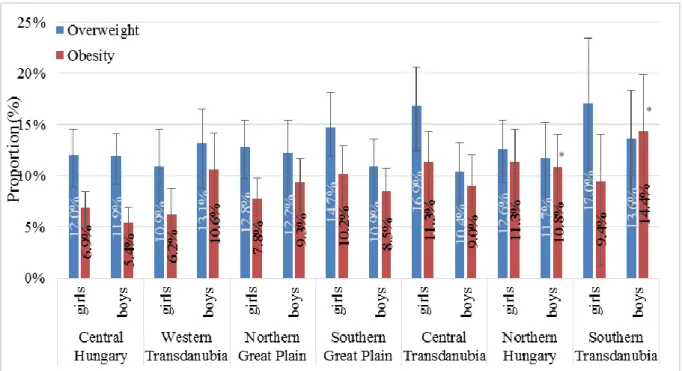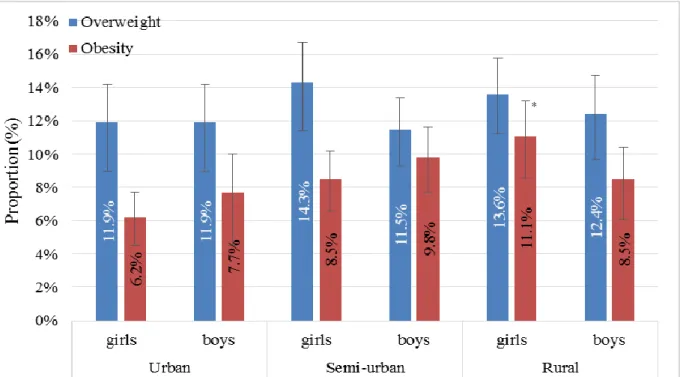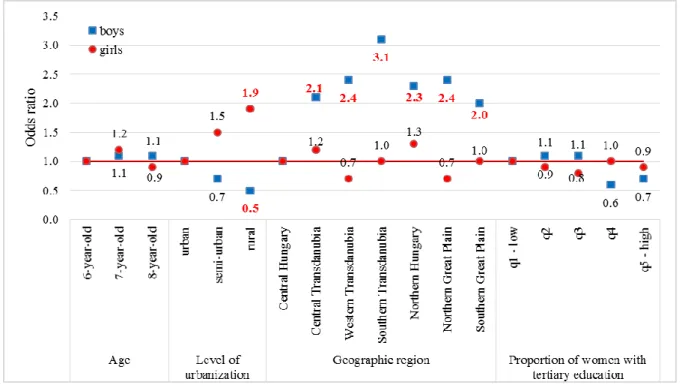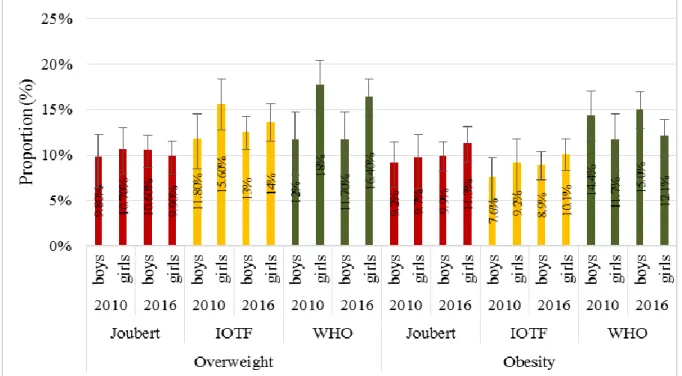Prevalence, regional differences and certain sociodemographic correlates of childhood overweight and obesity
PhD thesis
Gergő Erdei
Doctoral School of Pathological Sciences Semmelweis University
Supervisor: Erzsébet Mák, Ph.D
Official reviewers: Andrea Fogarasi-Grenczer, Ph.D József Vitrai, Ph.D
Head of the Complex Exam Committee:
Anna Blázovics MD, D.Sc Members of the Complex Exam Committee:
Éva Gelencsér, C.Sc Edit Czeglédi, Ph.D
Budapest 2018
2
Introduction
I deal in my doctoral dissertation with the prevalence, regional differences of childhood overweight and obesity, and their correlations with certain sociodemographic factors. Our results draw attention to the fact that remarkable differences can be observed in the prevalence of childhood overweight and obesity, which may be related to certain sociodemographic indicators. According to our study, effective interventions are needed in order to prevent childhood overweight and obesity.
Overweight and obesity among children are one of the most crucial public health issues of our time, whose prevalence is growing at an alarming rate. Child overweight and obesity have significant medical, social and economic impacts even in childhood.
Several studies investigated the differences in obesity prevalence between urban and rural areas, but the results are controversial. The majority of studies found higher overweight and obesity prevalence in rural areas compared to urban areas, however others have found the opposite. Besides, the pathways that lead to variation in the prevalence between urban and rural areas are not well understood. Possible explanations might be the social and cultural diversity, which in some cases are influenced by lower educational attainment and the variety in the presence of certain risk factors between urban and rural environments, such as less possibilities for physical activity due to higher distance to recreational facilities, transport options or due to safety concerns for active mobility in rural areas. More possibilities for eating out particularly in fast food restaurants or higher costs of fruit and vegetables in urban settlements may also partly explain this phenomenon. Finally, residents in rural areas may lack access to primary prevention efforts.
Research investigating regional differences in obesity prevalence have received less attention, particularly in child population. It appears that area level socio-economic and cultural factors are important predictors of childhood obesity, however the exact causes of regional differences in the prevalence rates are not clear yet.
3
Aims
The first aim of our study was to determine the prevalence of childhood overweight and obesity and its temporal change. The second aim was to get information about the overweight and obesity prevalence both according to urbanization level and in different geographic regions. This work also aimed to study the sex effect on these differences.
During our study, we were looking for answers to the following questions:
1. What is the prevalence of childhood overweight and obesity in 2016?
2. What is the difference between the prevalence of overweight and obesity by sex?
3. What is the difference in the prevalence of overweight and obesity according to the Joubert (national), the World Health Organization (WHO) and the International Obesity Task Force (IOTF) criteria?
4. How to change the prevalence of childhood overweight and obesity among seven Hungarian regions?
5. Is there any difference in the childhood overweight and obesity based on population density?
6. What is the risk of childhood overweight and obesity?
7. How did the prevalence of overweight and obesity change between 2010 and 2016?
4
Methods
WHO Childhood Obesity Surveillance Initiative (WHO COSI) examines the prevalence of childhood overweight and obesity on the largest sample, with the same methodology in European region. The survey collects data every three years since 2007 and today it runs in more than 40 countries. It aims to collect data about the prevalence of childhood overweight and obesity with standard methods (standard protocol, identical measuring devices) and its temporal change. COSI studies children aged 6-9 years and estimates the prevalence rate of obesity based on a national representative sample. Children's body weight and body height measurements, as well as schools' environment survey were carried out under COSI in Hungary. The COSI protocol is in accordance with the International Ethical Guidelines for Biomedical Research Involving Human Subjects. The Hungarian COSI survey was approved by the National Scientific and Ethical Committee (61158–2/2016/EKU).
The target population was defined as children aged 7.0-7.9 years on September 1, 2016. Data were gathered in a 4-week-long period between 3rd and 31st October, 2016. Following the COSI protocol, we aimed for a minimum sample size of 2800 pupils. Assuming 90% response rate and taking a design effect of 1.2 we have planned to enroll 3100 children. To draw a national representative sample, two-stage stratified sampling procedure was applied. The first stage sampling was stratified on counties. In this stage 155 schools from the sampling frame of size 2370 were selected. For the second stage we used a simple random sampling, choosing one 1st and 2nd classes within each previously selected first stage. Taking into account the number of measured children, the planned sample size was estimated 6200 pupils. During the study 5454 first and second grade children were measured. After the exclusions the final data set contained 5332 measured children. During the statistical analysis we used the post weighting based on sex, age and place of residence to reduce errors resulting from sampling and non-measurement. As a result, nationally representative data is available for the 6-8 age groups.
To ensure comparability with other works, prevalence rates are presented both according to the Hungarian definitions, IOTF and to the WHO. However, for analyzing the differences by the level of urbanization and by regions prevalence rates are only demonstrated according to the IOTF criteria as these cut-off values are closer to Hungarian national cut-off values than the WHO cut-offs, particularly for obesity where the WHO cut-offs are much lower than either the national or the IOTF cut-offs.
Considering that the aim also was to study the overweight and obesity prevalence according geographic regions, it can be divided into seven regions according to Nomenclature of
5
Territorial Units for Statistics (NUTS2): Northern Hungary, Northern Great Plain, Southern Great Plain, Southern Transdanubia, Western Transdanubia, Central Transdanubia, and Central Hungary.
Beyond the geographic distribution, residence of children were grouped into urban, semi- urban or rural categories based on the population density. As a result of the widespread English terminology I will use urban, semi-urban and rural labels.
Pearson χ2 test was used for categorical variables to test independence. The mean values between two independent samples were compared using independent sample t-test after testing for normality with 95% confidence interval (95% CI). Multivariable logistic regression was used to estimate odds-ratios (OR) for childhood overweight and obesity with 95%
confidence interval (95% CI). For dependent variable overweight or obesity was used; level of urbanization, age, and different geographical regions as independent variables at once were included in the models.
A p value < 0.05 level was considered statistically significant. We used STATA 11 statistical software for population estimates and data analysis.
6
Results
The most important new results of my doctoral thesis are the following:
Prevalence of overweight and obesity among 6-8 year-olds
Figure 1 shows the prevalence of overweight and obesity among children aged 6-8 year-olds (boys and girls together) according to Joubert, IOTF and WHO categories. Depending on which definition we used the prevalence of overweight varied from 9.3% to 15.0% and the prevalence of obesity was between 8.2-13.6%. In case of overweight, the lowest prevalence showed the Joubert criteria for all three ages (6-year-old: 9.3%; 7-year-old: 10.3%; 8-year- old: 9.7%), and the highest when using the WHO definition (6-year-old: 12.6%; 7-year-old:
14.8%; 8-year-old: 15.0%). The differences between them were 3.3%, 4.5%, and 5.3%. In case of obesity, the lowest prevalence showed using the IOTF criteria for all three ages (6- year-old: 8.3%; 7-year-old: 9.5%; 8-year-old: 8.2%), and the highest when using the WHO definition (6-year-old: 11.3%; 7-year-old: 13.6%; 8-year-old: 13.0%). The differences between them were 3.0%, 4.1%, and 4.8%. The prevalence of overweight increased as the age progress, using the IOTF criteria (11.3%; 13.0%; 13.4%) and WHO definition (12.6%;
14.8%; 15.0%). However, according to the Joubert criteria, the highest prevalence was among the 7-year-olds, while among the 8-year-olds it slightly decreased (10.3% vs. 9.7%). In obesity, all three categories showed the highest prevalence among the 7-year-olds. Interesting fact that the prevalence of obesity among 6 and 7-year-olds based on Joubert criteria exceeded the prevalence of overweight (9.5% vs. 9.3%; 10.6% vs. 10.3%).
7
Figure 1. Prevalence of overweight and obesity among 6-8-year-old children using Joubert, IOTF and WHO definitions.
Prevalence of overweight and obesity among 6-8-year-old children by geographic regions
The prevalence of overweight by girls was the highest in Southern Transdanubia (17.0%; CI:
10.6-26.1%), while it was the lowest in Western Transdanubia (10.9%; CI: 7.3-16.0 %). In the case of overweight, there was no significant difference between the regions by girls. The prevalence of overweight by boys was the highest in Southern Transdanubia (13.6%; CI: 8.9- 20.2%) similar to girls. However, the prevalence of overweight was the highest in Central Transdanubia (10.4%; CI: 7.6-14.0%) among boys. There was no significant difference between the regions by boys similar to girls.
In the case of obesity, the highest prevalence was in Northern Hungary (11.3% CI: 8.1- 15.6%) and Central Transdanubia (11.3% CI: 4.5-8.3%) by girls and the lowest prevalence was in Western Transdanubia (6.2%: CI: 3.7-10.3%). Significant difference, like obesity, was not found by girls.
In case of boys, obesity was the highest in Southern Transdanubia (14.4%; CI: 8.9-22.6%) and Central Hungary (5.4%; CI: 3.9% -7.5%). South Transdanubia (14.4%) and North Hungary (10.8%; CI: 7.6% to 15.1%) compared to Central Hungary (5.4%) also showed significant differences by obese boys. The biggest difference (nearly three times) was observed between Central Hungary and Southern Transdanubia.
8
Figure 2. Prevalence of overweight and obesity among 6-8-years old children by geographic regions, according to IOTF criteria.
*p <0.05
Prevalence of overweight and obesity among 6-8-year-old children by the level of urbanization
The prevalence of overweight by girls was the highest in semi-urban areas (14.3%, CI: 11.9- 17.2%), while the lowest in urban cities (11.9%, CI: 9.6 -14.8%). However, the prevalence of overweight by boys was the lowest in semi-urban areas (11.5%; 9.6-13.7%) and it was the highest in rural areas (12.4%; CI: 10.1-15.1%).
The prevalence of obesity by girls was directly proportional to the population density of the place of residence. It was the highest in rural areas (11.9%; CI: 9.0-13.6%), the lowest in urban areas (6.2%; CI: 4.7-7.9%). There was a significant difference between them. The prevalence of obesity by girls was the highest in semi-urban category (9.8%; CI: 8.0-11.9%) and the lowest in urban areas (7.7%; CI: 5.4-10.9%). We could not detect significant sex difference.
*
*
9
Figure 3. Prevalence of overweight and obesity among 6-8-years old children by urbanization levels, according to IOTF criteria.
*p <0.05
Multivariable analysis
Multivariable analysis was used to investigate the probability of overweight or obesity among children of 6-8 years (boys and girls together) based on each explanatory variable. The explanatory variables were the gender, age, urbanization levels, the geographic regions and the proportion of women with tertiary education. Among them the information about the proportion of women with higher education was obtained from the regional statistic of the Hungarian Central Statistical Office (KSH). From the explanatory variables, the first one was compared to the other elements of the category. Significant differences in each variable were indicated with red colour. Multivariable analysis in obesity as an output variable was examined by gender (Figure 4). We did not find any significant difference as the age progresses by boys (1.1; 1.1). The odds ratio of obesity among the 7-year-old girls was higher (1.2), while among the 8-year-old girls (0.9) was lower than the 6-year-olds.
The settlements got even lower odds ratio compared to urban areas by boys (0.7; 0.5). There was significant difference between rural and urban areas (p = 0.027). However, it was the opposite by the girls, the lowest population density had the highest odds ratio for obesity (1.5;
1.9). There was also a significant difference between urban and rural areas (p = 0.038).
*
10
In case of regional differences, boys had higher odds ratio in all areas compared to Central Hungary. The differences were always significant. The highest odds ratio had Southern Transdanubia (3.1). The girls' regional results were widely different from the boys, but there is no significant difference between them in either region.
The high proportion of women with higher education among boys and girls showed that higher rates of women with tertiary education resulted lower odds ratio in obesity.
Figure 4. Odds ratio for obesity among 6–8 years old Hungarian girls and boys based on IOTF criteria. The explanatory variables were the gender, age, urbanization levels, the geographic regions and the proportion of women with tertiary education. Significant differences in each variable were indicated with red colour.
The differences between 2010 and 2016 in the prevalence of overweight and obesity The prevalence of overweight decreased in all three categories by girls. The highest decrease was according to IOTF definition (2.0%) and the lowest based on Joubert category (0.8%). It increased according to Joubert and IOTF categories and it was constant according to WHO (0%).
The prevalence of obesity among both girls and boys was growing. The overweight was higher based on Joubert definition by girls than boys in 2010 (10.7% vs. 9.8%), but it changed in 2016 (9.9% vs. 10.6%). According to Joubert criteria the prevalence of obesity was higher by girls both in 2010 and 2016. Using the IOTF reference both the prevalence of overweight
11
and obesity were higher by girls than boys. However, the prevalence of overweight was higher by girls and the prevalence of obesity was higher by boys according to the WHO growth reference. Nevertheless, there was not significant difference between sexes.
Figure 5. The prevalence of overweight and obesity in 2010 and 2016 based on Joubert, IOTF and WHO categories.
12
Conclusions
Based on our results, the following conclusions can be drawn:
1. Overweight and obesity affects every fourth or fifth children in the 6-8 age groups (depending on which definition we used).
2. The three different criteria which were used to determine the nutritional status of children showed significant differences in prevalence of overweight and obesity.
3. The prevalence of overweight increased among 6-8-year-olds as the age progress.
4. Significant gender differences have been found in the prevalence of overweight and obesity. Overweight among girls, while obesity among boys were more common.
5. The prevalence of overweight and obesity shows remarkable regional differences. The highest prevalence was found in Southern Transdanubia (15.2%, 12.0%), while the lowest prevalence was found in Central Hungary (12.0%, 6.1%) among the seven Hungarian regions. In case of obesity, the difference was almost twice between the highest and lowest ones.
6. The prevalence of overweight and also obesity were the highest in the lowest population density areas (overweight: urban: 11.9%, semi-urban: 12.8%, rural: 13.0%, obesity: urban: 7.0%, semi-urban: 9.1%, rural: 9, 8%).
7. Based on the multivariable analysis, the boys had higher odds ratio for obesity as the age progress.
8. The odds ratio of obesity among girls increases with the decline of population density, while we found higher odds ratio of obesity in lower population density areas among boys.
9. In examining the regions, the prevalence of overweight and obesity were the highest in Southern Transdanubia.
10. Increasing the proportion of women with tertiary education decreased the odds ratio for childhood obesity.
11. The prevalence of overweight and obesity in 2016 showed only a small increase but stable results compared to 2010.
13
New results of my doctoral dissertation
1. The regional prevalence of childhood overweight and obesity was described for the first time in Hungary.
2. Multivariable analysis was applied in examination of nutrition status of children using socio-demographic indicators as an output variable first in our country.
3. The results of the study provide data about the prevalence of childhood overweight and obesity on the basis of the level of urbanization as never done before.
4. The assumed factors behind the regional differences of nutritional status were described also for the first time, which could be the basis for planning targeted interventions.
5. Along with this work now two good quality survey results based on the same methodology are available and suitable for international comparison to help tracking the prevalence of childhood overweight and obesity.
6. It can be considered as a scientific result which was carried out with an international methodology that can support shaping a joint strategy to tackle obesity in Europe.
14
List of publication
Publication related to the dissertation
1. Erdei G, Bakacs M, Illés É, Nagy B, Kaposvári C, Mák E, Nagy ES, Cserháti Z, Kovács VA. (2018) Substantial variation across geographic regions in the obesity prevalence among 6-8 years old Hungarian children (COSI Hungary 2016). BMC Public Health, 18:611. [IF (2017) 2,420]
2. Erdei G, Kovács VA, Bakacs M, Martos É. (2017) Országos Táplálkozás és Tápláltsági Állapot Vizsgálat 2014. I. A magyar felnőtt lakosság tápláltsági állapota. Orv Hetil, 158:533-540. [IF (2016) 0,349]
3. Erdei G, Varga A, Nagy B, Miháldy K, Nagy-Lőrincz Zs. (2018) Magyarországi vízfogyasztást népszerűsítő program a gyermekek körében. Új Diéta, 18:8-11.
4. Kovacs VA, Bakacs M, Kaposvari C, Illes E, Erdei G, Martos E, Breda J. (2018) Weight Status of 7-Year-Old Hungarian Children between 2010 and 2016 Using Different Classifications (COSI Hungary). Obes Facts. 11:195-205. [IF (2018) 3,108]
15
Publications not related to the dissertation
1. Nagy B, Bakacs M, Nagy-Lőrincz Zs, Erdei G, Sarkadi Nagy E, Cserháti Z. (2017) A magyar felnőtt lakosság tej- és tejtermék fogyasztása az Országos Táplálkozás és Tápláltsági Állapot Vizsgálat 2014 eredményei alapján. Új Diéta, 5:10-14.
2. Nagy B, Nagy-Lőrinc Zs, Bakacs M, Illés É, Sarkadi Nagy E, Erdei G, Martos É. (2017) Országos Táplálkozás és Tápláltsági Állapot Vizsgálat: OTÁP2014 IV. A magyar lakosság mikroelem-bevitele. Orv hetil, 158:803-810. [IF (2016) 0,349]
3. Gilingerné PM, Csambalik L, Erdei G, Simon P. (2013) Hagyományos paradicsomtípusok likopin- és C-vitamin-tartalmának változása az érés során. Új Diéta, 22:17-19.
